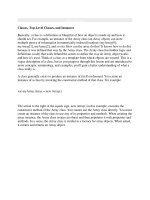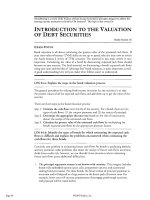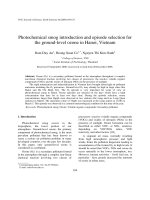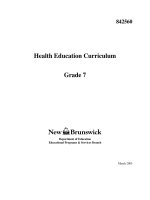GRADE LEVEL CONTENT EXPECTATIONS: Grade Six docx
Bạn đang xem bản rút gọn của tài liệu. Xem và tải ngay bản đầy đủ của tài liệu tại đây (393.09 KB, 8 trang )
GRADE LEVEL CONTENT EXPECTATIONS
HEALTH EDUCATION
Grade Six
Welcome to Michigan’s Health Education Content Standards
and Expectations for Grade Six
Why Develop Content Expectations for Health?
Good health is necessary for academic success. Like adults at work, students at school have difculty being
successful if they are depressed, tired, bullied, stressed, sick, using alcohol or other drugs, undernourished, or abused.
Research shows that effective health education helps students increase their health knowledge and improve their
health skills and behaviors, especially those behaviors that have the greatest effect on health.
The Centers for Disease Control and Prevention (CDC) has identied the risk behavior areas that have the greatest
effect on the short-term and long-term health of young people. Patterns of unhealthy eating, physical inactivity, and
tobacco use are often established in childhood and adolescence, and are by far the leading causes of death among adults.
Injury and violence, including suicide and alcohol-related trafc crashes, are the leading causes of death among youth.
Each year approximately three million cases of sexually transmitted infections occur among teenagers, and one in four
Michigan high school students reports having consumed ve or more drinks in a row during the previous month. These
behavioral areas should be emphasized in an effective health education program: healthy eating, physical activity, tobacco
prevention, alcohol and other drug prevention, injury and violence prevention, and the prevention of sexual behaviors
leading to HIV/STI infections or pregnancy.
In its Policy on Comprehensive School Health Education, the State Board addresses these risks by recommending that
Michigan schools do the following.
• Provide at least 50 hours of health at each grade, Prekindergarten through Grade Twelve, to give students
adequate time to learn and practice health habits and skills for a lifetime.
• Focus on helping young people develop and practice personal and social skills, such as communication
and decision making, in order to deal effectively with health-risk situations.
• Address social and media inuences on student behaviors and help students identify healthy alternatives
to specic high-risk behaviors.
• Emphasize critical knowledge and skills that students need in order to obtain, understand, and use basic
health information and services in ways that enhance healthy living.
• Focus on behaviors that have the greatest effect on health, especially those related to nutrition; physical
activity; violence and injury; alcohol and other drug use; tobacco use; and sexual behaviors that lead to HIV,
sexually transmitted disease, or unintended pregnancy, as developmentally appropriate.
• Build functional knowledge and skills, from year to year, that are developmentally appropriate.
• Include accurate and up-to-date information, and be appropriate to students’ developmental levels,
personal behaviors, and cultural backgrounds.
The content expectations contained in this document are intended to help schools address these recommendations.
GRADE 6 HEALTH CONTENT EXPECTATIONS 1/07 2 OF 8 MICHIGAN DEPARTMENT OF EDUCATION
Overview of the Content Expectations
The Health Education Content Expectations reect legal requirements, best practices, and current research in the
teaching and learning of health education. They build from the Michigan Health Education Standards and Benchmarks
(1996) and the State Board of Education’s Policy on Comprehensive School Health Education (2004). These content
expectations represent a vision for a relevant health education curriculum that addresses critical health knowledge and
skills for successfully maintaining a healthy lifestyle during a child’s school years and beyond.
The Health Education Content Standards and Expectations were developed with the input of work groups made up of
health content experts and faculty from teacher preparation programs, focus groups of teachers and parents, and online
reviews by grade level teachers. They are aligned with the 2006 National Health Education Standards; assessment items
developed by the State Collaborative for Assessment and Student Standards, Health Education Project of the Council
of Chief State School Ofcers; and the Michigan Model for Health
®
Curriculum. Students whose work is guided by these
standards and expectations will be prepared for responsible and healthful living, at school, at home, and in the workplace.
GRADE 6 HEALTH CONTENT EXPECTATIONS 1/07 3 OF 8 MICHIGAN DEPARTMENT OF EDUCATION
Michigan Health Education Content Standards (2006)
1. Core Concepts All students will apply health promotion and disease prevention
concepts and principles to personal, family, and community health issues.
2. Access Information All students will access valid health information and appropriate health
promoting products and services.
3. Health Behaviors All students will practice health enhancing behaviors and avoid or reduce
health risks.
4. Inuences All students will analyze the inuence of family, peers, culture, media, and
technology on health.
5. Goal Setting All students will use goal setting skills to enhance health.
6. Decision Making All students will use decision-making skills to enhance health.
7. Social Skills All students will demonstrate effective interpersonal communication and
other social skills which enhance health.
8. Advocacy All students will demonstrate advocacy skills for enhanced personal,
family, and community health.
Please note that, while all the Content Standards are addressed in these Grade Level Content Expectations for
Health Education as a whole, not all standards will be addressed in each strand.
STRAND 1: NUTRITION AND PHYSICAL ACTIVITY
Standard 1: Core Concepts
1.1 Analyze the benets of healthy eating and being physically active.
1.2 Identify the causes of foodborne illness.
1.3 Explain how weight management is inuenced by healthy eating and being physically active.
Standard 3: Health Behaviors
1.4 Describe the federal dietary guidelines and the amount of physical activity recommended for one’s age in order
to achieve health benets.
1.5 Describe strategies for dealing with personal preferences, restrictions, and barriers related to healthy eating,
adequate sleep, and physical activity.
1.6 Describe environmental inuences that encourage or discourage physical activity.
1.7 Develop a dietary and physical activity plan for a week that is consistent with the dietary guidelines.
1.8 Demonstrate the ability to support others to choose healthy foods and be physically active.
RECOMMENDED
Standard 1: Core Concepts
1.9 Describe the relationship of self perception, body image, body weight, and physical activity.
Standard 4: Influences
1.10 Analyze how one’s own perception of weight inuences healthy eating and being physically active.
STRAND 2: ALCOHOL, TOBACCO, AND OTHER DRUGS
Standard 1: Core Concepts
2.1 Explain the short- and long-term effects of alcohol and marijuana use.
2.2 Explain school policies and Michigan laws related to the sale and use of tobacco products.
2.3 Analyze data that supports that most young people in middle school do not use tobacco, alcohol,
or other drugs.
2.4 Articulate the benets of remaining alcohol, tobacco, and drug free.
2.5 Analyze how impaired judgment and other effects of alcohol or marijuana use impact personal safety,
relationships with friends and families, school success, and attainment of present and future goals.
Standard 2: Access Information
2.6 Demonstrate the ability to locate school and community resources to assist with problems related to
alcohol and other drug use; and assess the validity of the resources.
Standard 3: Health Behaviors
2.7 Make a commitment to be alcohol, tobacco and drug free.
2.8 Recognize behaviors that may indicate alcohol or drug impairment in order to avoid riding with an
impaired driver.
2.9 Describe strategies to avoid riding with an impaired driver, and demonstrate the ability to use them.
Standard 4: Influences
2.10 Analyze family, peer, societal, and media inuences on tobacco, alcohol, and other drug use.
Standard 7: Social Skills
2.11 Develop personal strategies to resist inuences to use tobacco, alcohol, and other drugs.
2.12 Demonstrate verbal and non-verbal ways to refuse alcohol, tobacco, and other drugs.
Health Education Expectations Grade Six
GRADE 6 HEALTH CONTENT EXPECTATIONS 1/07 4 OF 8 MICHIGAN DEPARTMENT OF EDUCATION
GRADE 6 HEALTH CONTENT EXPECTATIONS 1/07 5 OF 8 MICHIGAN DEPARTMENT OF EDUCATION
STRAND 2: ALCOHOL, TOBACCO, AND OTHER DRUGS (CONTINUED)
RECOMMENDED
Standard 1: Core Concepts
2.13 Describe the negative health effects of caffeine, tobacco, and diet pills on rest, stress, athletic performance, and
weight management.
Standard 4: Influences
2.14 Analyze possible reasons why individuals choose to use, or not use, alcohol or marijuana.
2.15 Demonstrate the ability to support friends and family members who are trying to stop using alcohol, tobacco,
and other drugs.
Standard 8: Advocacy
2.16 Apply effective persuasion skills for encouraging others not to use tobacco, alcohol, and other drugs.
STRAND 3: SAFETY
Standard 1: Core Concepts
3.1 Explain how safety belts help passengers to stay safe.
3.2 Describe safety hazards related to using the Internet.
3.3 Describe appropriate and inappropriate touch.
3.4 Explain the importance of respecting personal space and boundaries.
3.5 Explain that a child is not at fault if someone touches him or her in an inappropriate way.
Standard 2: Access Information
3.6 Demonstrate the ability to ask a trusted adult for help when feeling personally threatened or unsafe, including
while using the Internet.
Standard 3: Health Behaviors
3.7 Analyze environments and situations, including those where weapons may be present, to determine whether
they are safe.
3.8 Describe strategies to avoid unsafe situations.
3.9 Demonstrate strategies to escape when weapons/dangerous objects are present.
3.10 Describe the procedure for reporting the presence of weapons at school.
3.11 Demonstrate the ability to escape safety hazards in public places.
3.12 Apply school rules and procedures to hypothetical school crisis situations.
3.13 Demonstrate strategies to get away in hypothetical cases of inappropriate touching or abduction.
3.14 Apply strategies to stay safe when using the Internet.
Standard 4: Influences
3.15 Explain how one’s behavior, when an occupant of a vehicle, inuences the behavior of others.
RECOMMENDED
Standard 8: Advocacy
3.16 Advocate for others to practice safe behavior, including the proper use of safety belts, when riding in a car.
3.17 Advocate for others to stay safe when using the Internet.
GRADE 6 HEALTH CONTENT EXPECTATIONS 1/07 6 OF 8 MICHIGAN DEPARTMENT OF EDUCATION
STRAND 4: SOCIAL AND EMOTIONAL HEALTH
(Note: Teaching these standards is central to the implementation of an effective Positive Behavior Support system.)
Standard 1: Core Concepts
4.1 Describe some common causes of stress, and the health effects of stress.
Standard 2: Access Information
4.2 Analyze the importance of getting help from an adult when it is needed.
4.3 Identify criteria to determine whether another person is able to help one make healthy decisions and solve
problems; and apply these criteria to identify people who can provide help.
Standard 3: Health Behaviors
4.4 Demonstrate the ability to use practical strategies to manage strong feelings.
Standard 5: Goal Setting
4.5 Use practical strategies to develop a personal plan for stress management.
Standard 6: Decision Making
4.6 Describe the decision making and problem solving steps.
4.7 Demonstrate the ability to make a decision or solve a problem using criteria to evaluate solutions.
Standard 7: Social Skills
4.8 Describe the characteristics of conicts that can be resolved and the steps of effective conict resolution.
4.9 Demonstrate the ability to use the steps of conict resolution.
4.10 Demonstrate effective listening strategies.
4.11 Demonstrate the ability to use assertive communication skills appropriately.
RECOMMENDED
Standard 1: Core Concepts
4.12 Analyze how friendships may involve positive and negative risks.
4.13 Explain the difference between angry feelings and angry behavior.
Standard 7: Social Skills
4.14 Demonstrate the ability to express appreciation.
STRAND 5: PERSONAL HEALTH AND WELLNESS
Standard 3: Health Behaviors
5.1 Demonstrate skills throughout the day to reduce the spread of germs.
GRADE 6 HEALTH CONTENT EXPECTATIONS 1/07 7 OF 8 MICHIGAN DEPARTMENT OF EDUCATION
STRAND 6: HIV AND STIs PREVENTION
See the Health Education Content Expectations for Grade 5 and Grades 7-8 at www.michigan.gov/
healthed< />STRAND 7: SEXUALITY EDUCATION
(Note: State law makes whether to offer sexuality education a local district decision. Course content must
be reviewed by the district’s Sex Education Advisory Board to determine whether it is consistent with the
district’s board policies and approved sexuality education curriculum. If the district chooses to offer sexuality
education, certain content must be included in an age-appropriate fashion in the K-12 instructional program.
This content is integrated into these content expectations. For the specic language of the law, see Sections
380.1507, 1507a, and 1507b of the Michigan Compiled Laws at www.michiganlegislature.org.)
Standard 1: Core Concepts
7.1 Describe the changes in friendships that one might experience as a result of puberty, and evaluate what it means
to be a boyfriend or girlfriend.
7.2 Identify changes in physical maturation during puberty as it relates to the physical capacity for human
reproduction.
7.3 Describe the basic process of human reproduction, using scientic names for reproductive anatomy.
7.4 Dene abstinence from sex.
7.5 Analyze reasons for young people to remain abstinent, concluding that abstinence is the only 100% effective
method of protection from HIV, other serious communicable disease, and pregnancy.
Standard 2: Access Information
7.6 Locate adult resources (e.g., parent, teacher, medical professional, counselor, other adult) who can provide
accurate information about friendships, dating, puberty, and human reproduction.
Standard 3: Health Behaviors
7.7 Recognize situations or behaviors that may lead to engaging in sexually risky behaviors.
7.8 Set personal boundaries and limits related to physical intimacy and sexual behavior.
Standard 4: Influences
7.9 Evaluate a variety of external inuences (e.g., media, parents, culture, peers, and society) and internal inuences
(e.g., values, curiosity, interests, desires, and fears) and their potential to impact relationships and behavior.
Standard 5: Goal Setting
7.10 Develop personal short- and long-term goals that support abstinence.
Standard 7: Social Skills
7.11 Demonstrate how to communicate one’s level of readiness to be a boy friend or girl friend.
7.12 Identify ways to show respect for other’s boundaries and limits related to physical intimacy and sexual behavior.
7.13 Demonstrate the ability to use verbal and non-verbal ways to refuse participation in sexual behavior.
GRADE LEVEL CONTENT EXPECTATIONS
HEALTH EDUCATION
Michigan Department of Education
Grants Coordination and School Support
Mary Ann Chartrand, Director
(517) 373-4013 www.michigan.gov/mde
Michigan
State Board
of Education
Kathleen N. Straus
President
Bloomeld Township
John C. Austin
Vice President
Ann Arbor
Carolyn L. Curtin
Secretary
Evart
Marianne Yared McGuire
Treasurer
Detroit
Nancy Danhof
NASBE Delegate
East Lansing
Elizabeth W. Bauer
Member
Birmingham
Reginald M. Turner
Member
Detroit
Casandra E. Ulbrich
Member
Rochester Hills
Gov. Jennifer M. Granholm
Ex Ofcio
Michael P. Flanagan
Chairman
Superintendent of
Public Instruction
Ex Ofcio
Carol Wolenberg
Deputy Superintendent
Mary Ann Chartrand
Director
Grants Coordination
and School Support
Acknowledgements
Academic Review
Jennifer Black, Monroe County ISD
Cheryl Blair, Kent ISD
Al Craven, Genesee ISD
Marty Doring, Bay-Arenac ISD
Mariane Fahlman, Wayne State University
Deborah Foster, Plymouth-Canton Community Schools
Shelly Foy, Swan Valley School District
Marianne Frauenknecht, Western Michigan University
Kathy Gibson, Wayne County RESA
Joni Henretty, Grand Ledge Public Schools
Pauline Pruneau, Oakland Schools
Pamela Sook, Gratiot-Isabella RESD
Theresa Stinson Lahring, Fruitport Community Schools
Mary Margaret Utess, Lansing IHM- St. Casimir School
Warren Wood, Carrollton Public Schools
Health Content Expert Review
Beverly Baroni-Yeglic, Southgate Community School District
Laurie Bechhofer, Michigan Department of Education
Shannon Carney Oleksyk, Michigan Department of Community Health
Deborah Grischke, MSU Extension: Michigan TEAM Nutrition
Jessica Grzywacz, Michigan Department of Community Health
Karen Krabill Yoder, Michigan Department of Community Health
Teri Wilson, Michigan Department of Community Health
Internal Review
Nicholas Drzal, Michigan Department of Education
Barbara Flis, Parent Action for Healthy Kids
Kyle Guerrant, Michigan Department of Education
Nancy Haney, Haney & Associates
Nancy Hudson, Council of Chief State School Officers
Martha Neilsen, Michigan Department of Education
Christine Reiff, Michigan Department of Labor & Economic Growth
Merry Stanford, Michigan Department of Education









